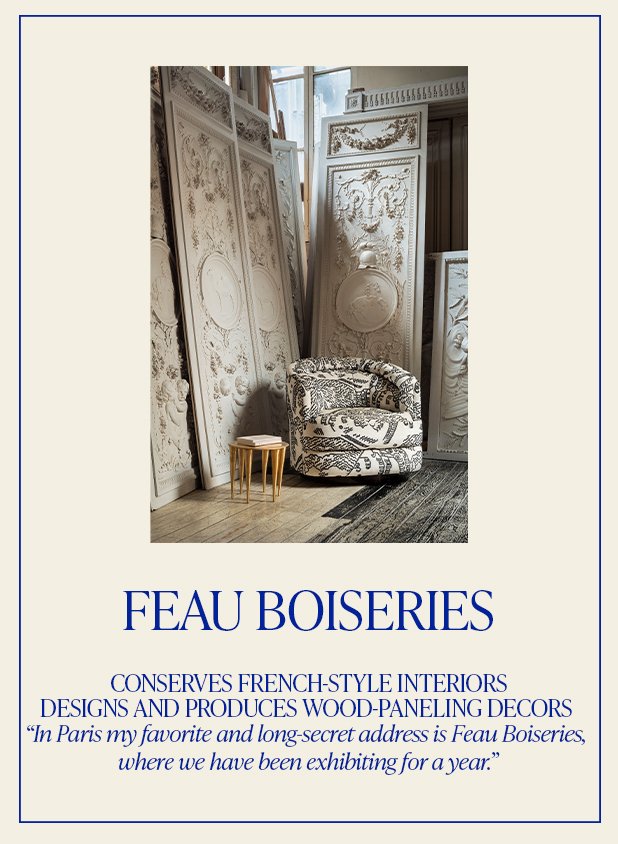Unraveling the Bespoke Interior Market, One Design at a Time
Courtesy of La Collection
ISABELLE DUBERN-MALLEVAYS
Unraveling the Bespoke Interior Market, One Design at a Time
By Bonnie Langedijk
The world of fashion and interior design have collided in more ways than one. As consumers crave for complete lifestyle experiences, brands have had to flex their creative muscles to create new product ranges outside of their usual offering. From luxury fashion players launching their own homeware and interior design lines, to high street giants applying their fast fashion tactics to coveted design objects. Isabelle Dubern-Mallevays has been bridging the gap between interior design and fashion years before the industries became closely intertwined. As the former Artistic Director for Dior Maison and Artistic Adviser for Diptyque Home, she was instrumental to the creation of both brands’ homeware collections.
While the fashion industry tried to capitalize on the $616 billion global home decor market, the former Dior Maison Artistic Director came across another industry gap waiting to be filled. With the rising popularity of luxury interior design, (the $23 million global luxury furniture market is expected to grow to over $42 million in 2031) you would expect every part of the industry to be highly commercialized. But, many of the pieces created by top level interior designers are custom made for private projects and clients, where they remain hidden and inaccessible to the general public. Together with co-founders Anna Zaoui and Lily Froehlicher, Dubern-Mallevays launched The Invisible Collection, a luxury design marketplace offering a curated selection of these unique pieces to design novices and seasoned collectors globally. From The Invisible Collection’s New York showroom Dubern-Mallevays shared her thoughts on the intersection of fashion and design, accessibility in the luxury market and how buying a fake is sometimes part of the journey to getting the real thing.
The Invisible Collection founders Isabelle Dubern-Mallevays, Anna Zaoui and Lily Froehlicher. Courtesy of The Invisible Collection
Courtesy of The Invisible Collection
Bonnie: Why did you decide to launch The Invisible Collection?
Isabelle: We didn't have a business plan in the beginning. We were just absolutely crazy about beautiful furniture. We saw that some of the furniture we loved was completely hidden [from the general public]. Famous top interior designers often design pieces for private projects, never selling them to consumers. We identified different pieces of furniture we loved. From there, we reached out to each designer. They had often lost the pictures, or they didn't know where the pieces were. It was a treasure hunt. We now work with almost 200 designers. It's scary sometimes to think about how fast we did it.
“In the beginning all of our designers were absolutely AFRAID of digital. As I lived this experience with fashion, I wasn't surprised by the designers' mindset.”
The Invisible Collection is a digital first company, and over the past few years companies across all industries have had to move online. How do you think the shift to online has impacted the interior design industry?
Isabelle: In the beginning all of our designers were absolutely afraid of digital. As I lived this experience with fashion, I wasn't surprised by the designers' mindset. For them it felt a little common maybe. It was chicer to be shown in a gallery then online. Online was more for the mass market stuff. Twenty years ago fashion had a similar mindset, while today the front row is filled with influencers.
I think there’s two elements to it. It’s about exclusivity and being scared to be mass, as you mentioned. Secondly, it’s the belief that you can’t showcase the craft that goes into a design within an online environment.
Isabelle: And in the end, they discover everything is possible. You can both stay niche and [embrace] digital. You can share your message in your own way. It might even be more clear than one bad sales person in a gallery.
You see it happening in the art world too. It creates more accessibility. I always go back to the example of walking into a luxury fashion store for the first time. I think a lot of people find that quite intimidating.
Isabelle: I experienced this when I worked with Dior Maison. For a while I worked on Dior and The Invisible Collection simultaneously. The days were for Invisible Collection and the nights for Dior. I created this collection for Dior Maison and very naively asked: “Will this collection be sold on the website too?" And they said: "No, this is a confidential project. It will only be sold in stores.” Of course, five years later Dior started selling the collection online.
Courtesy of The Invisible Collection
While we’re on the topic of Dior Maison, how do you translate the DNA of a fashion house into interior design?
Isabelle: Going back only a few years ago, it was quite anecdotal for fashion companies to take an interest in homeware. When Dior asked me to create a homeware line, we took some of the classic codes of the house and worked with artists and craftsmen to create a collection. Christian Dior was a collector and a gallerist, and my dream was for every piece to become a collector’s item. As the things for the home often outlast most of your clothes. At the time the different categories of the company – fashion, homeware and beauty were quite separated. Now it's different and they have decided to adopt a more unified, 360 approach, applying all the fashion codes and seasonal to every homeware item.
Completely. That new approach at Dior reflects what’s happening across the board. People are looking at their lifestyle as a whole. Especially as everything is shared on social media. Sometimes I wonder if that’s influencing the pace of the interior design industry, and how people shop for their home.
Isabelle: I am confident that trends for the home will have more longevity than fashion trends. It's also a matter of sustainability and responsibility. I can't imagine you have a plate for the season and ignore it the following season.
No, me neither. It has had a positive impact too. There’s a newfound interest for design and interiors. Everyone now has access to information and references.
Isabelle: Interior design used to be quite feminine too. Cushions and curtains and plates were something for girls. Now it's a serious business. But it's funny because I speak with many different clients and journalists in the US and UK and all of us have the same references. So something that isn’t mass market at all, becomes mass market in a way. Digital has pushed this forward. Twenty years ago you would have to find this one, niche magazine in print to get your information. Now everything is at your fingertips through Instagram, blogs and websites.
And I love that, but it comes with a dark side. There are some iconic designs that are shown and referenced continuously, almost making them a new trend. Then they’re copied by either high street companies or smaller independent boutiques, and you get this fatigue around these classic designs.
Isabelle: But the same happened in fashion maybe years ago? When I was a teenager, I dreamed about Chanel. I asked two friends to buy me a fake Chanel t-shirt from the market. My goal was to one day buy a real bag. Maybe the younger generations dream to own something, but they buy the fake version for now to hopefully own the real thing one day.
The Invisible Collection showroom in London. Courtesy of The Invisible Collection.
The Invisible Collection collaboration with DimoreMilano. Courtesy of The Invisible Collection.
Definitely. And let’s be real, many of these designs aren’t accessible to everyone. I think it’s healthy to grow into the purchases you make. But let’s go back to The Invisible Collection. There are many advantages to building a digital-first business. What were some of the biggest challenges of building a digital first brand?
Isabelle: The challenge was to grow with our clients. Some of the designers we worked with didn't even have pictures of their furniture. We’re sometimes compared to NET-A-PORTER and MATCHES[FASHION] but the difference is that they work with companies that have dedicated teams for supply chain and production. The designers we work with have other activities. They design hotels, residential spaces globally. They aren’t solely focused on selling furniture. Our challenges weren’t digital, they were more production related. That’s how we created our niche.
They're focused on the bigger picture and the furniture is just one element of it. And you also create custom pieces too, right?
Isabelle: It's 80% [of the business]. You can imagine that comes with many complications and complexities.
Creating custom furniture sounds like quite an intimate decision making process. How do you still create that human experience as a digital business?
Isabelle: We have sales teams everywhere in the world. They are in charge of the relationship with our clients. We often have to send samples, or we help consumers find pieces that fit their home. You can't buy custom furniture the same way you buy a dress on MATCHES[FASHION] and have it delivered in 90 minutes. It's impossible for furniture. Nobody can buy anything on the website without human interaction.
This interview has been edited and condensed for clarity.














